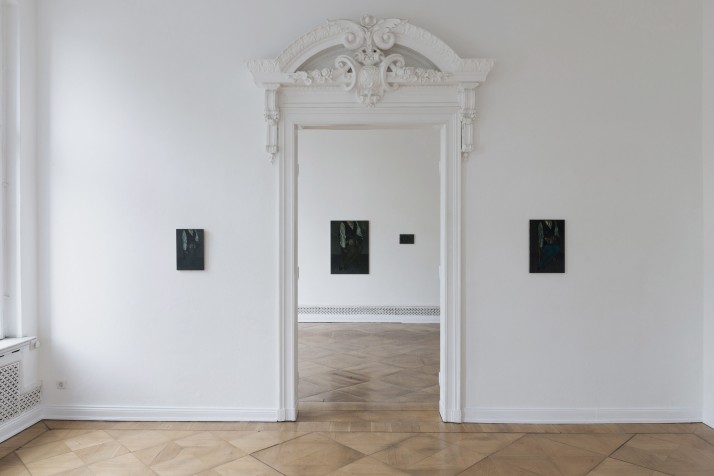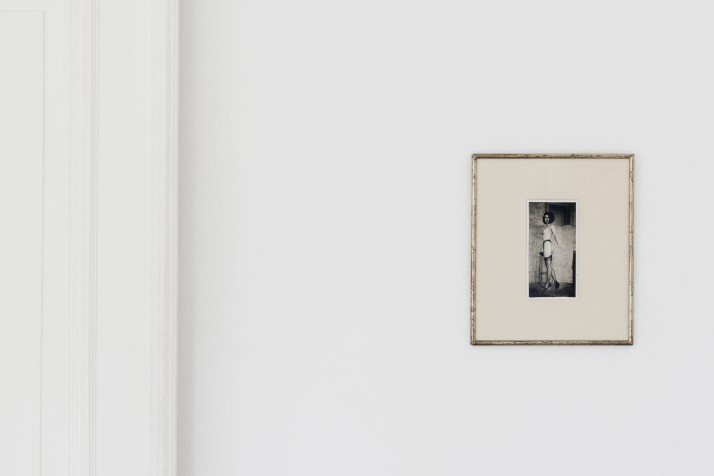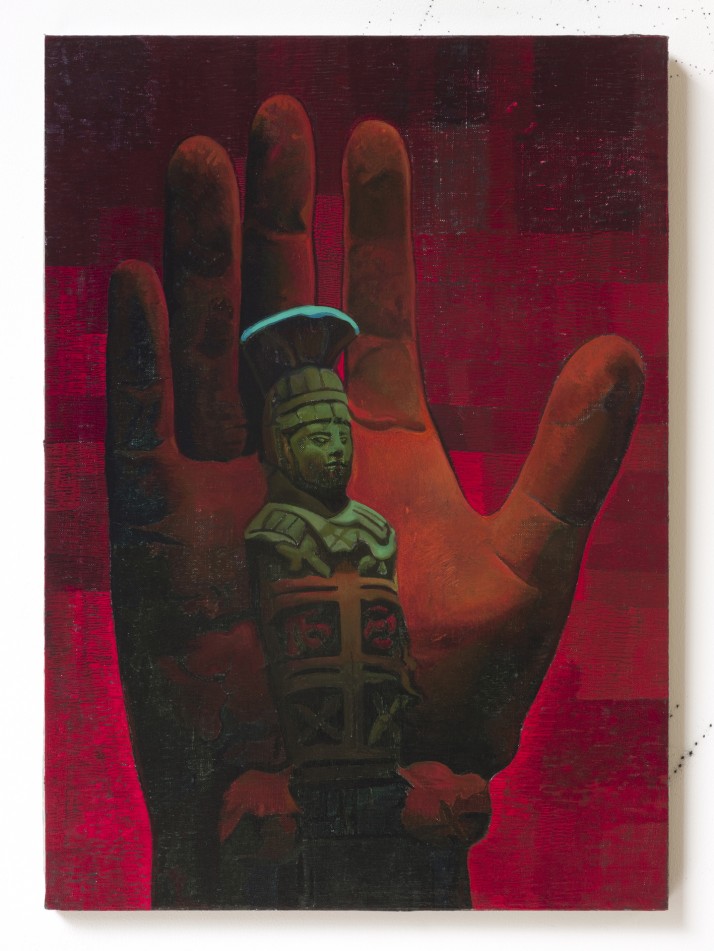Why did I think for a moment that I could present a text that contained all the corrections and deletions made during its genesis? Why did I want tostrew in bits of invented or false information, backed up by extensive footnotes? What kind of textual quick sand would that have become, and what triggered these bold desires? Maybe it’s just the casual style of this work of print. Perhaps I had already gotten caught up in the maelstrom of narrative tactics occasionally used, to the best of my knowledge, by Victor Man. Put in negative terms, I had planned an adaptation; in positive terms, a transference of the dark moods that Man often performs with hypnotic intensity. But it nevercame to that.
Imagine briefly the following: a series of three or four rooms in a bourgeois style, built around 1900, connected to one another by centrally placed doors. Deceptive, arbitrary, dreamed, or simply very dark, almost black paintings hang on the walls, arranged in pairs next tothe doors, facing only in one direction. Standing with one’s back to the wall at either end of the series of rooms, two different views or states result. In both cases, one sees the sequence of an enfilade. But in the one direction, all that would be visible is a white wall and a doorframe that opens a view of more white walls and doorframes. From the other side, things would look different: now the paintings hanging next to the doors would be seen, two in each room.
If they were black or almost black pictures, then they would form rectangular holes on the white walls, whose presence threatens formlessness. Several things about this description apply to Victor Man’s exhibition, yet others do not. His paintings are not occasions for transcendental assertions; they are not windows on the absolute (aspainterly abstraction might well have been legitimated in the 1950s). But we should not underestimate the draw exerted by even very small canvases that were painted under more oblique, less programmatic, or “media-specific” prerequisites.
Victor Man’s paintings are not even black. A green-brown shade of umbradominates: but the dark “u” of this word already brings its own implications of depth into play. These are further deepened on the level of figuration, for umbra helps to provide the shadows for paintings that contain a touch of the abysmal. A black, violent surrealism here runs towards a contemporary reservoir.
For example, there are paintings of young people with black openings instead of eyes. One of these figures holds its hands together, another bears a head-shaped idol in its arms, a symbol for authority or some kind of ritual practice. Three additional paintings vary these motifs. Instead of a young figure, an older looking individualis depicted. The shoes, vest, blouse, ribbon, but also the crossed (and somewhat chubby) legs, pointing to the side, exhibit a certainladylike quality that recalls the bourgeois style of Pierre Klossowski’s Roberte cycle, but also generates a mood reminiscent of Raoul Ruiz’ film L’Hypothèsedu tableau volé.
While oneof this lady’s hands has slipped beneath her thigh, the other holds a severed head on her lap. This time, it is not an archaic artifact, but could be the head of a human being or a doll. Yet the exposed earand a complicated wavy hairstyle are striking, represented using anearly Renaissance cross-hatching. This series of three forms something of a sequence, for while the body remains stationary, the head turns slightly on its axis, introducing the theme of circular repetition. But not only the head balanced on the lap is severed, the woman’s head is also cut off, albeit in a metaphorical sense, bythe upper edge of the image.
Head without body, bodies without a head: they are equally triggers foranxiety. These motifs create explicit references, that in so doing take on the status of a line of tradition. Think of Georges Batailleand the journal Acéphale, which he co-edited. With the term and the image of the acephalous, inthis context the capacities associated with the brain are discreditedor should at best be obliterated (the senses, and above all vision, reason and the ego). What once had been called the “nethermost forces of the soul” was shifted to the middle part of the body andto the realm of the unconscious, sexuality, and desire.
André Masson’s illustrations serve as emblems of this acephalous thinking. One of his better-known (for example modeled by Cerith WynEvans as a neon piece) shows a male body without a head, that, standing upright, holds its arms in a victorious pose toward the outside. In the one hand, he holds a burning heart, in the other adagger, the hole of the anus is moved slightly towards the front, stars replace the nipples, a skull covers up the genital.
A similar form of covering takes place in Victor Man’s paintings. Under the inscription “titanik bar,” a head melancholically restson a fist. On the fist, there is a small skull covering the eye. Thatis another way to deny vision its central importance; elsewhere Mandeprived vision of its material.
Victor Man’s paintings not only trace out lines of tradition, they alsoshift them. In his work, the image of the acephalous is tied to figures with an undefined transgendered aspect. These hieroglyphs for gender confusion exude a powerful eroticism that triggers contradictory affects of disgust and arousal. The gender polarity is suspended at the price of the uncanny, based on the fact ofcastration and a fatally lacking phallus. The fact that the lacking phallus returns elsewhere, in the black-and-white photographs by Pierre Molinier, as a dildo attached to a black pumps´ heel, is, asit were, an uncanny return.
It has been claimed several times that the French influences and resonances provide Man’s productions with historical depth. But the differences need to be pointed out. According to the surrealists, theunconscious was a source of imagination that all people share (art/painting was only an attribute or a start). The truth of the sexualization of all life expression was pronounced loudly. Victor Man’s paintings are not lacking in these aspects. There is a clear propinquity to aggression and to horror. But it appears in quiet and almost gentle ways. Man’s eroticism is intimate and rather locked.
Manfred Hermes
Victor Man
The Third Cover
20.09.2013 – 09.11.2013


